Please click here to go to the most recent version of this course
The “small things” of care are particularly important in ensuring that care is genuinely supportive of the individual and enhances that person’s autonomy and well-being. The humanity with which assistance for everyday living is offered, especially help with eating and intimate care, is crucial in helping the person retain their self-esteem and dignity, as are the manner and tone in which a person is addressed; the care taken to ensure that they participate as much as they can or wish in any decision about their day-to-day life; the trouble taken about appropriate and attractive food and environments; and access to meaningful activity.
Nuffield Council on Bioethics
Activities of daily living (ADLs) are the tasks we do during our daily lives. Because ADL skills decline as dementia progresses, caregiver involvement naturally changes over time. Caregivers often help more than is needed and research suggests that people with dementia—even those with advanced dementia—can do more than caregivers allow them to do.
Promoting independence requires good communication, patience, and the ability to understand and accept that dementia changes how a person approaches an activity. Many caregivers assume someone with dementia is child-like and no longer capable of understanding how to complete an activity. Many caregivers, family members, and healthcare providers simply take over the task. This not only robs people of their independence; it affects their self-worth.
ADLs are generally divided into basic ADLs and instrumental ADLs. Basics ADLs are the skills needed to take care of personal needs such as:
- Eating
- Bathing or showering
- Grooming
- Walking
- Dressing and undressing
- Transfers
- Toileting
Instrumental ADLs (IADLs) are the skills needed to function within society and within the community. As with basic ADLs, these skills decrease as dementia progresses. IADLs include:
- Housework
- Financial management
- Shopping
- Preparing meals
- Communicating with the outside world
- Medical and medication management
As a direct caregiver, medical professional or family member, the following best principles should be understood and applied to all activities of daily living at all stages of dementia:
- Engage people with dementia in interventions and solutions
- Manage pain
- Maintain a supportive environment
- Take a holistic approach
- Compensate for a person’s reduced abilities
- Embed interventions in day-to-day life
- Provide ongoing support
- Involve caregivers
- Get dementia-friendly training and develop skills for working with people with dementia
- Understand and know your patient
- Train caregivers
- Collaborate with healthcare professionals and family members
(Wheatley et al., 2019)
General Strategies for Promoting Independence in ADLs in Various Stages
Even with proper training and mentoring, it’s nearly impossible to be a great caregiver all the time. It’s no fun getting up in the middle of the night to clean up after an incontinent family member. It’s almost impossible to be patient when your mom swears at you, screams, hits, bites, collapses during a transfer, or refuses to eat. But the dementia training I found online and the support from hospice helped a lot—it gave me strategies and techniques to use when all seemed lost and when nothing was working.
Family Caregiver, Ft. Lauderdale, Florida
Good Communication is the Basis for Success
Good communication starts with patience and thoughtfulness. Good communication builds trust, encourages independence, and leads to better outcomes. Caregivers must learn and believe that consistently trying to understand the needs of the person they are caring for will make their job easier. Good communication takes into account a person’s ability to comprehend, their sensory abilities, and their culture.
In the home setting, communication may be easier because the environment is familiar with fewer distractions although caregivers are often alone and cannot turn to a co-worker for help. No matter what setting, a calm tone, short direct sentences, a slow rate of speech, and patience encourages independence in people with dementia.
Case Example
Clara is a 96-year old, Caucasian woman with severe macular degeneration, significant hearing loss corrected with hearing aids, and moderate to severe dementia. She lives at home in Jacksonville, Florida and is generally very cooperative and agreeable. Her daughters stay with her for 4 days each week and have hired a caregiver for the other days. Her current caregiver has a thick accent and poor English skills and doesn’t understand that Clara can’t hear her and often doesn’t understand what she’s saying. The caregiver sometimes forgets to give Clara her hearing aids, sometimes puts the hearing aids in with dead batteries, leaves the TV on when trying to talk to Clara, and speaks in long, complicated, thickly accented sentences. She uses phrases and words that are completely unfamiliar to Clara.
For example, when the caregiver wanted Clara to wipe herself after she finished urinating, she asked Clara to “wipe her jewel.” Clara had no idea what she was talking about. Clara always tries to respond to her caregiver, even when it’s clear she has no idea what she’s being asked to do. Because Clara responds, the caregiver swears Clara understands her and is just being stubborn when Clara doesn’t do what’s asked. Clara’s daughter has tried to explain but the caregiver ignores her.
ADL Skill Training
ADL “skills training” is recommended for all caregivers—both family and professional. Emphasis is on encouraging independence in all activities while providing appropriate assistance when needed. ADL skills training promotes involvement in self-care, minimizes caregiver stress, and reduces the amount of physical labor required of a caregiver.
A skilled caregiver learns to continually assess the strengths, comprehension, and capabilities of the person they are caring for. More or less assistance may be needed depending on the task, the time of day, co-morbidities, and level and type of dementia. For example, a person who is otherwise capable of independent self-care tasks but has poor balance might need help setting up a place to safely brush her teeth and do other grooming. If forced to stand during these activities, the person may need more help from the caregiver than is needed if a suitable sitting area is arranged.
Caregiver skills training provides caregivers with information, strategies, and tools to develop an individualized program that provides just the right amount of assistance. This might involve gestures, verbal and visual cues, assistive devices, planning and problem solving, and physical assistance.
Planning Activities
Planning an activity for someone with dementia must account for a person’s abilities and interests, which promotes success and leads to a wider range of activities. Well-planned activities will naturally arise from a careful assessment of a person’s lifestyle, occupation, interests, and preferences. For example, a person who loved to go for hikes but can no longer walk will still enjoy going for a drive or visiting a park with paths that accommodate wheelchairs. That same person may not enjoy sitting in front of a television tuned to a game show.
Assistive Technologies
Assistive technologies—devices designed to enable people with a disability to function more independently—have been developed to support people with dementia and their caregivers. Assistive technologies focus on safety and social participation. They are different than assistive devices, which aid with mobility and physical activities of daily living.
Assistive technologies:
- Provide the caregiver with a way to make sure the person they are caring for is safe.
- Provide help with memory and recall.
- Improve a person’s confidence and independence.
- Keep people with dementia socially connected.
Examples of assistive technologies include:
- Face-to-face communication with family members and friends using tablets or computers.
- Tracking devices, that allow a person to walk independently within a safe area.
- Electronic prompts and medication reminders.
- Medical check-ups via telephone or video conferencing.
- Automated lights.
- Automated shut-off sensors that prevent flooding or turn off devices that have been left on.
- Communication aids such as adapted telephones with pre-set numbers.
- Cameras mounted throughout the home.
Assistive technologies can reduce the cost of care, decrease caregiver burden, promote independence and autonomy, and increase quality life for people with dementia. They may also promote aging in place, delay transfer into a care facility, and help people with dementia maintain independence (Czarnuch et al., 2016).
Adaptive Aids
Adaptive aids are devices and equipment designed to assist a person with daily activities such as mobility, transfers, dressing and grooming, bathing, and eating. They can help individuals with disabilities compensate for lost functions, increase their independence, and develop their potential (Yeung et al., 2016). The selection of an adaptive aid or device depends on the person’s level of dementia, preferences and lifestyle, and physical abilities.
Adaptive aids include:
- Safety devices such as grab bars, transfer poles, handrails, and non-skid mats.
- Assistive devices such as walkers, wheelchairs, braces, height-adjustable chairs and beds, pulleys and slings, ramps, and lifts.
- Devices to assist with eating and drinking such as non-tip cups, assistive tableware, non-spill cups, adjustable-height tables, and easy-grip silverware.
- Devices for washing and bathing such as commodes, shower chairs, transfer benches, and walk-in or roll-in showers.
- Devices for household tasks such as adjustable-height cupboards, reachers, grip extensions for appliance controls, and pull-out shelves or pull-down shelves.
Preventing Loss of Independence through Exercise
Conventional exercise programs such as walking, resistance training, and seated exercises that focus on improving aerobic endurance, strength, balance, and flexibility have beneficial effects on physical function in individuals with dementia. Exercise improves the ability to perform basic activities of daily living such as eating, dressing, bathing, using the toilet, and transferring from bed to chair (Barnes et al., 2015). Homes that are dementia-friendly (and safe) promote independence and physical activity. This means they are safe for walking, easy to navigate, and have plenty of places to sit and rest.
Care Techniques
Care techniques are the skills needed by the caregiver for monitoring, assisting, and providing total care in dressing, grooming, eating, bathing, or toileting and incontinence. As dementia progresses, the amount of care a person with dementia requires understandably changes.
Dressing and Grooming
As with other activities of daily living, people with dementia often need time to dress and groom. The caregiver must assess the person they are caring for to determine the amount of help needed, must be patient, and must resist jumping in to help if no help is needed. Depending on the severity of the dementia and co-morbidities such as visual and perceptual changes, balance, and strength—even the time of day—caregivers must train themselves to encourage as much independence as possible.
A person with mild dementia may not need any help with dressing and grooming. These are habits and activities that a person has developed and practiced over a lifetime; habits that rely on parts of the brain, including motor control, not generally affected in the early stages of dementia. A caregiver may need to lay out a person’s clothes or make suggestions, but generally a person with mild dementia can choose what clothing they want to wear and handle grooming without help. A caregiver may suggest using an electric razor, lay out grooming supplies, or provide tools to assist with dressing and grooming. At this stage, the caregiver’s role is to help as needed while promoting and encouraging independence.
In the moderate stage, depending on a person’s strength, balance, and flexibility, a caregiver will likely need to assist with at least some aspects of a person’s dressing and grooming. For example, Clara, mentioned earlier in this section has severe macular degeneration and moderate dementia. But she is very flexible and still fairly strong at the age of 95. When she’s sitting in a chair with proper back support, she can easily bring her knee up to her chest. However, she can’t see where to place her leg when she tries to put on her pants and she can’t see where her clothes are placed. It’s tempting to do everything for her, but this increases caregiver burden and fails to promote Clara’s independence. In this case, the caregiver must be patient—help Clara lay out her clothes and provide verbal and appropriate touch cues to direct the activity.
The same is true for grooming. For mouth care and other grooming tasks, caregivers must provide a safe and comfortable place for these tasks, assist as needed, and provide clear, step-by-step instruction and help. For men, especially in the moderate to severe stage of dementia, the use of an electric razor provides a safe way to shave, and for both men and women, regular visits to the beauty or barber shop provides social interaction and reduces caregiver burden.
As dementia progresses to a more severe stage, caregivers must provide more help with dressing and grooming. Many caregivers tend to overhelp, partly because the person with dementia takes a long time to complete what used to be simple and automatic tasks. In the home setting, schedules and routines for activities of daily living are more flexible than in a nursing home. Nevertheless, caregivers often get impatient (even bored) with the slow pace of dressing and grooming. Slowing down, encouraging independence, and maintaining an attitude of watchful patience are critical skills for a caregiver to develop and practice.
Eating and Hydration
Interventions to support older people with eating and drinking vary depending on the stage of a person’s dementia. There are certain general strategies that can be undertaken in the early stage and continued as a person’s dementia progresses. This includes assisting with the setup of a meal, providing a supportive seating arrangement, providing support for the feet, and making sure food is tasty, warm, and attractive. Other recommended practices include changing the color of a plate (for food contrast), encouraging daily exercise, and altering the meal schedule to suit the needs of the person with dementia.
When dementia is mild, a caregiver may only need to supervise. A person with mild dementia, depending on other underlying medical issues, will likely be able to help with shopping, cooking, and dishwashing. In the mild stage, a person might be able to prepare their own meals. A caregiver will likely need to supervise and help at a distance while assuring the person with dementia is safe. Mild memory problems can lead to safety issues such as forgetting to turn off the stove, leaving water running, or forgetting to eat or drink. A person with mild dementia may feel they are safe to drive—this is when a caregiver must step in address this issue.
As a person’s dementia progresses to the moderate stage, the need for caregiver assistance increases and safety issues arise. As balance and strength decline, the risk for falls increases and all activities of daily living, including eating and hydration are affected.
Mild swallowing difficulties may arise in the moderate stage, increasing the risk of aspiration and choking. This can be addressed by preparing softer foods, cutting food into smaller pieces, and avoiding food that is hard to chew or hard to swallow. Proper ergonomic seating and simple swallowing techniques can be taught at this stage to reduce the risk of aspiration. Caregivers should always encourage independence, encourage choice in food and drink, and allow the person they are assisting to do as much as they can on their own.
In the later stage, oral nutrition supplementation, food modification, and dysphagia management are a daily concern for caregivers. Eating assistance, encouragement, and social support have been shown to increase the amount a person with severe dementia eats and drinks. Eating can be an automatic behavior—we often eat when we see other people eating or when we smell something delicious cooking. A person with severe dementia can still help with meal preparation—even if they only beat an egg, peel an orange, or pour juice into a cup (with assistance). Remember that, especially in the home, spilled food can always be cleaned up.
Caregiver education and training is critical (and often lacking) throughout every stage of a person’s dementia but becomes particularly important as a person nears the end of their life. Behavioral issues may arise—refusal to eat and drink, blunt complaints about food taste and quality, throwing food, shouting, knocking over glasses, and refusal to come to the table. Many of these things can be avoided—especially in the home setting—by adjusting to, and listening to, a person’s changing needs.
Assistive Tableware
Assistive or adaptive tableware has been a mainstay in nursing homes and assisted living facilities for many years and is recommended for use in the home as well. Unfortunately, a lot of assistive tableware lacks aesthetic appeal. In a group setting (and even at home), users of assistive table settings may feel stigmatized because assistive tableware stands. In the home, a person may feel less stigma, but introducing tableware that significantly differs from the tableware someone has been using their entire adult life may be an issue for some people.
As eating difficulties develop and appetite decreases, meals must be simplified by providing just a plate and spoon with pureed or diced food. A plate with a high lip and slanted bottom helps a person push the food onto the spoon and scoop it up.
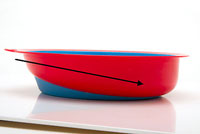
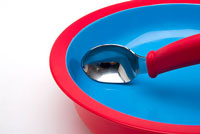
The slanted bottom hip lip of the plate can help users to gather food on one side without scooping. Spoon heads are designed to match the curvature of the bowls to pick up the food easier. Designed by Sha Yao, Eatwell.com. Used with permission. From http://www.eatwellset.com/#!features/cf1a
Well-designed assistive tableware can be used by people of all abilities, and at all stages of dementia. Color contrasts should feature prominently to provide contrast and visual cues—for example royal blue plates provide a contrast both with a white table covering and food on a plate.
The same approach can be used with cups. In the example below, a royal blue bottom and a white cover are used to help those with low visual acuity or agnosia locate the cup handle and rim. The sides of the cup are angled to reduce the need to tip the cup, a large handle assures a good grip, and a wide top allows a person’s nose to fit inside the cup when tipped.
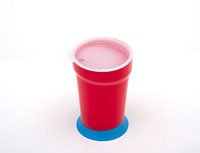
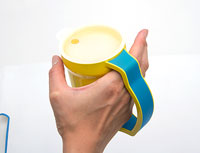
A cup with a weighted bottom is shown on the left. A cup with an easy-to-grip handle is shown on the right. Designed by Sha Yao, Eatwell.com. Used with permission.
Remember that dementia is a progressive disease, and a person will gradually lose the desire to eat. This can be extremely distressing for caregivers even though it is a normal part of the disease progression. Caregivers who have worked hard to keep a person eating and drinking may be alarmed as it becomes harder and harder to convince the person they are caring for to eat and drink. This will be accompanied by weight loss—sometimes severe.
Interventions that improve nutrition among people with dementia include, eating meals with caregivers, family style meals, soothing mealtime music, accessible snacks, longer mealtimes, education and support for formal and informal caregivers, facilitated breakfast clubs, and regular exercise (Bunn et al, 2016).
Other recommendations:
- Provide food that a person likes.
- Involve the person in food preparation.
- Give small portions.
- Experiment with different consistencies (milkshakes, smoothies).
- Use more flavoring.
- Provide food when a person is awake—even if that’s in the middle of the night.
- Be patient and use common sense.
Bathing
Throughout our lives, bathing is a private, independent, and personal experience. For someone with dementia, having another person help with bathing can be uncomfortable and even threatening. It is a caregiver’s responsibility to help the person they are caring for feel a sense of control and independence. This is accomplished by including the person is the bathing decision, encouraging independence, protecting the person’s privacy and dignity, and practicing flexibility.
During bathing, techniques that comfort and reassure a person during all stages of dementia include:
- Set a regular time for bathing
- Be gentle with fragile skin, avoid scrubbing
- Simplify the bathing process, use assistive devices
- Coach or cue the person through each step, if needed
- Offer a bench or shower chair for comfort and safety
- Assist with cleansing of hard-to-reach areas, if needed
- Use a sponge bath in between baths or as an alternative to bathing (Alzheimer’s Association, 2020a)
A person with mild dementia may not need help with bathing. At this stage, the responsibility of the caregiver is to assist as needed and encourage independence. This is best accomplished by making sure the bathing area is safe, warm, and comfortable. Grab bars and non-skid mats should be available. Bathing supplies should be within reach and the water pre-heated to the proper temperature, if needed.
In the moderate stage, additional safety equipment will likely be needed. This might include a shower chair, replacement of a shower door with a curtain, and a long shower hose. Depending upon a person’s physical capabilities, tub bathing may no longer be safe.
In the severe stage, direct help will likely be needed with bathing. Shower chairs, grab bars, transfer poles, and even modifications to the shower allowing a rolling shower chair may be needed. Caregivers should expect to get wet at this stage as they assist with bathing. They must still take care to encourage as much independence as is safe and possible.
There are times when a person may need to be bathed in bed. This is not uncommon at, or near, the end of life. Bed bathing is not as effective as showering and should only be used when there is no alternative. Cleanliness promotes skin health and supports dignity. Even at this stage, caregivers should encourage participation and consider a person’s preferences for bathing.
General principles for bed bathing:
- Keep the person warm
- Expose only the area being washed
- Change water when dirty and after washing genital areas
- Pat skin dry rather than rubbing
- Talk to the person (even someone who is unconscious)
Toileting and Incontinence
Incontinence is the involuntary leaking of urine or feces or both. No matter where a person lives, and how far their dementia has progressed, incontinence can be embarrassing and stigmatizing. Incontinence adds to caregiver stress and depression and is a factor in the decision to admit a family member to a care home.
There are a number of issues related to toileting and incontinence in people with dementia. Some are the result of the loss of cognition and memory, some from behavioral and psychological symptoms, and some from the interplay of these with other comorbidities. Over-medicating with laxatives (sometimes without the knowledge of the caregiver) can be a problem. For this reason, medications should be reviewed on a regular basis—especially when a medication is changed.
Many care providers believe that it is normal for older adults to be incontinent and as a result, reversible causes of incontinence are not adequately addressed. This may be because the person with dementia is too embarrassed to mention it, or the caregiver is not overly concerned.
Stress incontinence, which causes involuntary loss of urine, can sometimes be reversed through surgical interventions. Kegel Exercise—in which the floor of the pelvis is strengthened by regular contractions—can be of great help in this type of incontinence. An overactive bladder during a urinary tract infection may cause urinary retention as well as incontinence.
Some people require a combination of treatments such as anti-spasmodic medications with lengthened periods between toileting to increase bladder capacity to reduce wetting episodes.
A person with mild dementia (as well as those in the later stages), may be physically unable to get to the bathroom in time to void. They may hide this problem out of embarrassment or ignore the problem. They may have difficulty with cleansing and personal hygiene.
A person with moderate dementia may have decreased mobility, have difficulty getting to the bathroom, and may be unable to undo clothing once in the bathroom. Men may experience problems directing their penis—especially if balance is compromised and there is nothing to hold onto. Lack of grab bars or transfer poles are a problem of cleansing as well.
As dementia becomes more severe and physical, sensory, and cognitive skills continue to decline, it is not uncommon for a person to hide soiled underwear, hand feces to the caregiver, or wipe feces off hands onto clothing or furniture. A person may resist help entirely, fail to remove clothes before voiding, void in inappropriate places (the garden, next to the bed at night, in waste bins) (Drennan et al., 2011). Often the person with dementia will try to stop drinking liquids to decrease the frequency of urination. This can lead to constipation and urinary tract infections, creating a difficult and vicious cycle of dehydration, infection, and incontinence.
In the severe stage, a person may or may not be able to walk without assistance but, due to sensory changes and decreased vision, may have difficulty locating or recognizing the bathroom. This probably won’t stop a person from trying, increasing the risk of falls. Caregivers can find this stage extremely frustrating and stressful—partly because more physical help is required and more direct oversight is needed, and partly because more time is spent cleaning up accidents.
Techniques and strategies used by caregivers to manage toileting and incontinence in a person with dementia typically start with reminders to go to the toilet on a regular basis. As dementia progresses, other techniques are needed such as adult diapers, bedside commodes, and direct help from the caregiver. Assistive equipment is critical to promote independence and to decrease the amount of lifting for the caregiver.
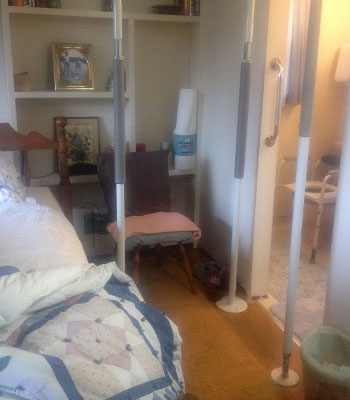
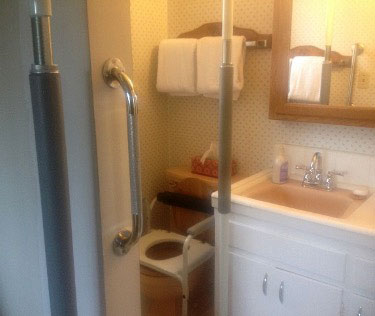
An example of a small bathroom with grab bars, shower chair, and floor-to-ceiling transfers poles used for a woman with moderate to severe dementia who could still walk with assistance, nearly to the end of her life, but had poor balance. She was able to safely go from her bed to the toilet without assistance until the last month of her life. The pole next to the sink was installed because she had a tendency to swing onto the toilet as soon as she got close, rather than stepping and turning. Prior to installing the pole next to the sink cabinet, she turned too soon and broke a lower rib when she hit the corner of the cabinet. She held on to the pole next to the chair for balance as she got dressed. The door was also removed from the bathroom to allow wheelchair access so she could safely stand or sit at the sink for grooming. Source: Author.
To make it easier for a person with dementia to find and use the toilet:
- Clear the path to the bathroom by moving furniture.
- Keep the bathroom door open so the toilet is visible.
- Put colored rugs on the bathroom floor or put a picture of a toilet on the bathroom door.
- Make the toilet safe and easy to use. Raise the toilet seat, install grab bars on both sides, and use nightlights to illuminate the bedroom and bath.
- Consider a portable commode or urinal for the bedroom for nighttime use.
- Remove plants, wastebaskets, and other objects that could be mistaken for a toilet.
- Remove throw rugs that may cause a person to trip and fall.
- Consider using glow-in-the-dark tape to create a direct line or path to the toilet (Alzheimer’s Association, 2020b).
Keep in mind that incontinence can be related to a medical problem such as urinary tract infection, constipation or prostate problems. Incontinence is also associated with diabetes, stroke, Parkinson’s disease, and physical disabilities that prevent the person from reaching the bathroom in time. Medications and diuretics (drugs that increase urination) can also cause incontinence. This includes sleeping pills, anxiety-reducing drugs that may relax the bladder muscles, and drinks such as cola, coffee and tea (Alzheimer’s Association, 2020b).
